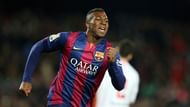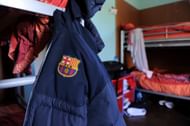Barcelona’s famed La Masia academy has long been held out as the example for every other club to follow. Year after year the Catalans would bring through players of the highest quality in a production line that was unmatched across the football world.
The secret in its success lies in the foundations laid by Johan Cruyff. The Dutchman applied the most simple of doctrines throughout the academy, and one which makes the transition to the first-team so much easier. When you break down Cruyff’s modus operandi, it’s incomprehensible why other teams don’t follow it to the letter.
The football model is an attacking one and is played from every age group from the very youngest inductees upwards. No matter the size and stature of its players, there is no deviation whatsoever from this one particular way of playing.
It allows players to develop a sound knowledge of the game, including positions, formations etc, and means that when they reach the senior levels of the club the players are fully versed in exactly the style and shape that is required. Not for the Catalans a handful of managers during the educational process all preaching and practising different methods. Of course, things might have changed if Cruyff’s way of playing had proved to be unsuccessful but until recently, Barca have enjoyed virtual blanket success at all levels.
Bringing up world class players from the academy has been a problem recently
The last few years have indicated a problem however. Not with the teachings of Cruyff per se, but the ability of the La Masia coaches to bring through any players of note. Players that are without question good enough to be classed as regulars in the first team.
Sergio Busquets and Pedro Rodriguez were the last two graduates to make an impression. Given that their introduction to the first-team came under Pep Guardiola in 2008, it brings into sharp focus the issue that concerns the club at present. It’s worth dwelling on the sheer amount of players since “Busi” who have tried and failed, to make a name for themselves at the club.
Bojan Krkic, a player who scored over 700 goals in half a dozen seasons at the academy, has probably been the most successful, having at least enjoyed a season or so in the limelight at Barca. But for players such as Marc Muniesa, Isaac Cuenca, Giovanni Dos Santos, Cristian Tello, Oriol Romeu and others, the road to success has come elsewhere. There have been plenty of others too. Andreu Fontas, Jeffren, Nolito, Alberto Botia, Martin Montoya, Gerard Deulofeu....the list is practically endless.
Adama Traore has recently left for Aston Villa and Patric Gabarron for Lazio and those ex-Barca B players lucky enough to be in and around the first team at the moment, aren’t making quite the impression desired. Marc Bartra, Sergi Roberto, Munir El-Haddadi and Sandro Ramirez have to step up to the plate this season or risk being the next in line to be packed off elsewhere.
Jean-Marie Dongou is another. A player who Spanish football expert Graham Hunter rated as the best he had ever seen at age 16 – yes even better than Messi – has gone backwards since a promotion to Barca B, a reserve side who now reside in the third tier of the Spanish football pyramid, relegated just a season after finishing with their highest ever points total in the league above, the Segunda Division.
For a club who produced Puyol, Xavi, Iniesta, Pique, Fabregas and Messi in the not so distant past, this is clearly an untenable situation. So where does the problem lie?
Success came at the cost of selling out their principles
Arguably the buying policy of the club has changed over the last few seasons. Immediate returns are desired and whilst not guaranteed with “Galactico” signings who still need to integrate, there is a better chance of success with ready-made world-class exponents than those who need to be schooled over time.
By way of example, it’s absolutely correct to suggest that the Catalans wouldn’t have won the treble without Neymar and Luis Suarez. Two players that were brought into the club at a combined cost of somewhere in the region of €150m.
Not signing such players is always an option but success nowadays comes at a price. That cost to Barca is the “selling out” of its principles. It goes against the grain for many, given that La Masia was always seen as a fundamental pillar of what Barcelona were about.
Bit by bit, everything that the club members held dear is being eroded. Shirt sponsorship was an inevitability in today’s financial climate but pulling the rug from under the feet of the youth at the club is a step too far. Is La Masia failing?
Well, it can hardly be classed as a success at this point. The distinct Barca style remains in evidence so it would be fair to assume that either the calibre of young player that is brought to the club just isn’t up to the job, in which case the scouting network needs an overhaul or, more likely, is that the coaching set-up isn’t up to the required standard.
That can certainly be evidenced by the decline of Barca B. When Luis Enrique was in charge of the youngsters whilst Guardiola was ripping it up with the seniors, the B team managed a third-place finish. And in some style it must be said.
The lull that followed was only temporarily abated by another third placed finish in 2013/14. Relegation the season after highlighted in big neon letters the huge problems that have beset the organisation.Had Joan Laporta been successful in his bid to become Barcelona president, bringing Cruyff back into the fold and making La Masia a focal point were all part of his mandate.
Josep Maria Bartomeu went ahead and bought Arda Turan and Aleix Vidal, thereby closing two spots on the team to the next generation of upcoming Blaugrana stars. It doesn’t take a mastermind to work out that the status quo will remain until the Catalans get back to basics, even if that means a paucity of silverware in the meantime.


